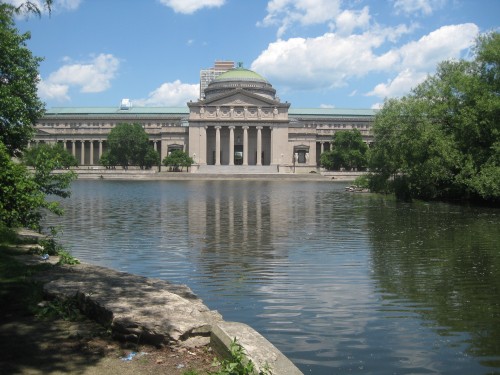Olmsted in the White City
I’m in Chicago visiting the site of the 1893 World Columbian Expo. Traces of the original White City, as the fair was called, and of Olmsted’s dazzling landscaping plan for it are still visible today.
The structures for the world’s fair were massive and many were designed by the premiere architects of the era such as Louis Sullivan and Daniel Burnham. Each huge building was dedicated to a different display — works of art from around the world, say, or the latest agricultural tools — for fair-goers to gape at.
Olmsted’s plan called for an intricate network of lagoons wending through the grounds. It was possible to travel around the fair in a gondola or in an electric launch. All the huge buildings had water entrances, too. So it was also possible to dock your boat and walk right up the steps, see below.

Alas, huge buildings such as this one were only temporary, executed in a kind of glorified papier mâché. After the fair, they were all supposed to come down — well, all except the Fine Arts Palace. Because it housed priceless paintings and sculptures from around the globe, this building was constructed in a more sturdy, fire-proof fashion.
Meanwhile, Olmsted’s landscaping was meant to be permanent. After the fair, after the paper-mâché buildings had all come down, his system of lagoons was supposed to remain and to become the central feature of Chicago’s Jackson Park.
Thanks to Julia Bachrach of the Chicago Park District for showing me a remnant of the White City still visible today (photo below). From the Clarence Darrow Bridge (called the Brazil Bridge during the fair), there’s a view across one of Olmsted’s original lagoons to what is today the Museum of Science and Industry. It was once the Fine Art Palace — the fair’s sole sturdy building.
What a view! A vestige of 1893 here in 2010. Of course, it requires a bit more imagination to gaze out across this scene and to picture people traveling the lagoons on brightly colored boats, taking a spin on the world’s first-ever ferris wheel, and being amazed, simply amazed, by what modernity had to offer.
